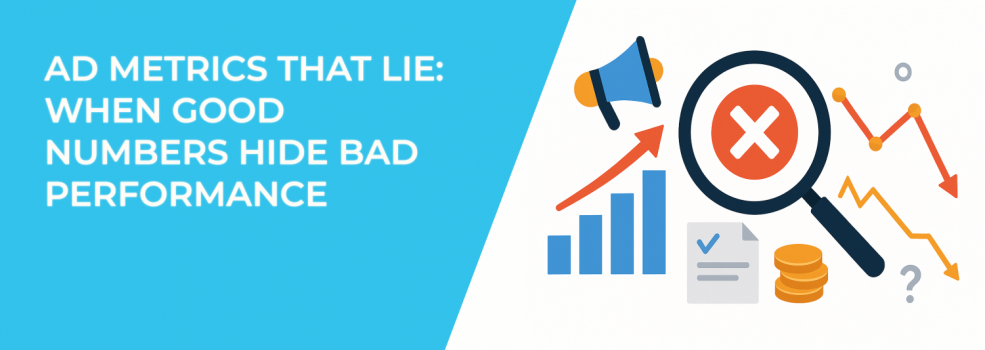In digital advertising, numbers can feel like the ultimate truth. Click-through rates rise, conversion percentages look solid, and return on ad spend seems healthy. But do those numbers always tell the real story? Not quite. Sometimes, metrics flatter campaigns that are quietly underperforming, leaving marketers with the illusion of success while revenue stalls.
This is where a critical look at data becomes essential. Let’s explore the ad metrics that often mislead, why they can be deceptive, and what you should track instead.
The CTR Mirage
Click-through rate (CTR) is often celebrated as a top-line measure of ad success. A rising CTR means people are interested, right? The problem is that clicks don’t always equal customers.
Imagine a campaign with a flashy headline or a vague promise. It grabs attention, people click, but once they hit the landing page, they drop off. That “high CTR” looks impressive in reports, yet it hides the fact that the ad isn’t bringing in qualified leads.
What to do instead: Pair CTR with post-click metrics like bounce rate, time on page, or cost per qualified lead.
Quick tips to improve CTR quality:
-
Write ad copy that matches the landing page promise.
-
Use precise targeting to attract the right audience, not just any audience.
-
Test headlines that balance curiosity with clarity.
Small tweaks like these help ensure clicks aren’t wasted. If you’ve seen CTR drop despite good creative, check out How to Solve Low Click-Through Rates (CTR) on Facebook Ads for practical fixes.
The ROAS Illusion
Return on ad spend (ROAS) is another favorite among advertisers. On the surface, it tells you how much revenue came in compared to how much you spent. But here’s the catch: not all revenue is equal.
Suppose your campaign drives a wave of low-margin sales. The ROAS may look strong, but when you factor in product costs, shipping, or returns, the actual profit could be razor-thin—or even negative.
Better measure: Track profit per conversion or customer lifetime value (CLV).
Tips to avoid ROAS traps:
-
Always compare ROAS with net profit, not just revenue.
-
Separate high-margin and low-margin product campaigns.
-
Factor in refunds and cancellations before celebrating.
Looking at ROAS in a vacuum often sets marketers up for disappointment. For a deeper dive into realistic revenue metrics, read How to Analyze Campaign Performance Beyond ROAS: The Full Funnel View.
Vanity Metrics That Distract
Some numbers are comforting but practically useless. Impressions, reach, and even engagement counts can fall into this trap. They show you that people saw or interacted with your ad, but they don’t tell you if those interactions brought value to the business.
A campaign might rack up millions of impressions, but if those eyeballs never convert, what’s the point?
Tip for focus: Anchor your evaluations around business impact metrics—qualified leads, conversions, revenue, or cost per acquisition.
Better questions to ask about vanity metrics:
-
Did this campaign actually change buying behavior?
-
Do these impressions translate into more website sessions?
-
Are engagements driving brand consideration or just attention?
If you’ve ever wondered what impressions really mean, check What Facebook Ad Impressions Really Mean (And What to Do With Them).
When Conversion Rate Misleads
Conversion rate looks like the gold standard. After all, it measures how many people completed a desired action. But the devil is in the denominator.
Let’s say you optimize for conversions by making the offer overly cheap or the form extremely short. Conversions rise, but quality falls. You get more sign-ups or orders, yet many of those leads churn quickly or purchases get canceled. The conversion rate improved on paper, but the business outcome worsened.
Pro tip: Combine conversion rate with lead quality scores, refund rates, or repeat purchase behavior.
Smart practices for healthy conversion tracking:
-
Score leads to separate serious buyers from freebie-seekers.
-
Track post-conversion actions like open rates, engagement, or churn.
-
Monitor refund and cancellation ratios as closely as you monitor conversions.
If you’re unsure what benchmarks to use, see What Is a Good Conversion Rate on Facebook Ads for context.
Engagement Isn’t Always Equal to Value
Likes, comments, and shares can feel like social proof. The dopamine hit of engagement makes campaigns look lively. But high engagement doesn’t automatically connect to sales.
For example, a clever meme ad might go viral, yet bring in little to no paying customers. The metric inflates the perception of success while the real conversion engine sputters.
Smarter angle: Compare engagement with downstream actions. Did those who engaged also add items to their cart, book a call, or join the email list?
How to make engagement meaningful:
-
Use CTAs in engaging posts that guide users toward a next step.
-
Track which engagement sources convert further down the funnel.
-
Run experiments to see if engaged users spend more over time.
To understand the difference between meaningful and empty engagement, check Why Tracking Engagement Metrics on Facebook Ads is Crucial for Success.
How to See Past the Numbers
So, what should advertisers do to avoid falling into the trap of misleading metrics? Here are a few practical approaches:
-
Context matters: Never look at one number in isolation. Pair top-of-funnel metrics with bottom-of-funnel outcomes.
-
Check the cost of results: A lead that costs $10 in one campaign but $25 in another doesn’t automatically mean the first campaign is better. What if the $25 lead closes at three times the rate?
-
Think long term: Lifetime value, retention, and repeat purchase rates often tell a richer story than short-term performance snapshots.
-
Ask better questions: Instead of “What was the CTR?”, ask “Did this ad bring in the right type of customer?”
Want more advanced insights? Explore How to Analyze Facebook Ad Performance Beyond CTR and CPC.
Final Thoughts
Numbers don’t lie, but they don’t always tell the whole truth either. Good-looking ad metrics can mask campaigns that drain budgets and fail to build sustainable growth. The smartest marketers question every number, connect surface-level results to business outcomes, and keep their eyes on the bigger picture.
So, the next time you look at a dashboard full of green arrows and rising percentages, pause for a moment. Are those numbers showing real performance—or just dressing up a weak campaign?

